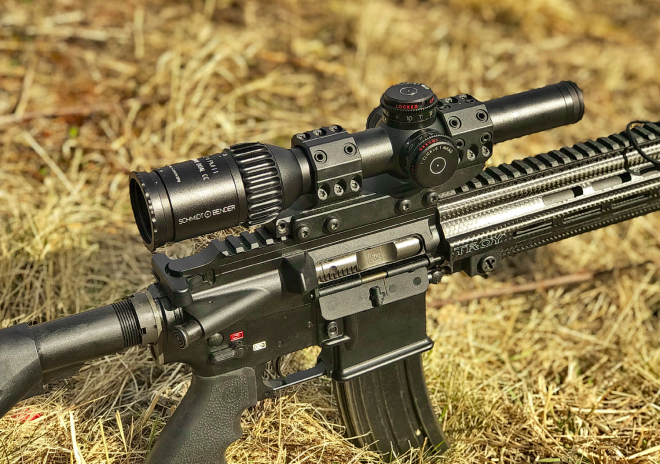The Firearm Blog is on a mission to review as many of the Schmidt & Bender PM II Riflescopes as we can. In case you didn’t know PM is short for Police & Military. Previously we had a look at the classic S&B 5-25×56 PM II with the LRR-Mil reticle, with a 5 power magnification range. An “oldtimer” still in young shape.
Later this year we will review the High Power line of Schmidt & Bender, which consists of the 3-27×56 PM II and the 5-45×56 PM II. The High Power versions have an impressive 9 power magnification range.
In this article, we’re going to take a closer look at the Schmidt & Bender 1-8×24 PM II ShortDot Dual CC.
With a huge number of pictures, we’ll walk you through this riflescope as well as the Spuhr mount, step by step.
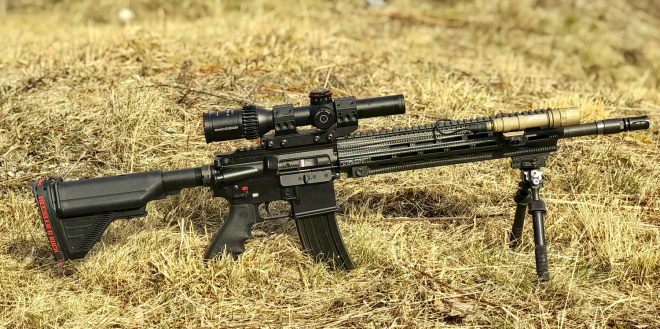
First Generation Heckler & Koch MR223 (from around 2010), with the Schmidt & Bender 1-8×24 PM II in a Spuhr mount. Surefire light, Atlas bipod and a carbon fiber handguard from Troy. The red thing at the back is just a rubber band with the HK logotype. Needs a Magpul K2+ pistol grip and a Geissele trigger.
The PM II ShortDot scipes are available in Black and RAL8000.
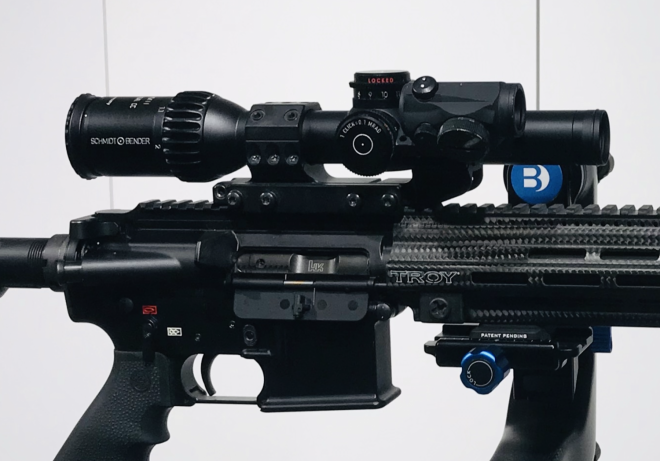
The Heckler & Koch MR223 on a Benro Gimbal GH5C Carbon Fibre head, Manfrotto tripod (outside picture). The HK has a carbon fiber handguard and sits with an ARCA RC2 M-LOK connector from Shadow Tech LLC.
Introduction
We might as well say it from the start: This is probably the World’s best Low Power Variable Optic for Designated Marksman-style shooting and sniping.
With the Close Combat (CC) mode activated you get 1x magnification with a 7-meter parallax and a FlashDot red dot-like illumination. This unique feature in combination with the potential of 8x power and a Mil based reticle gives the shooter a lot of optic performance, from close range to surely 600 to 800 meters.
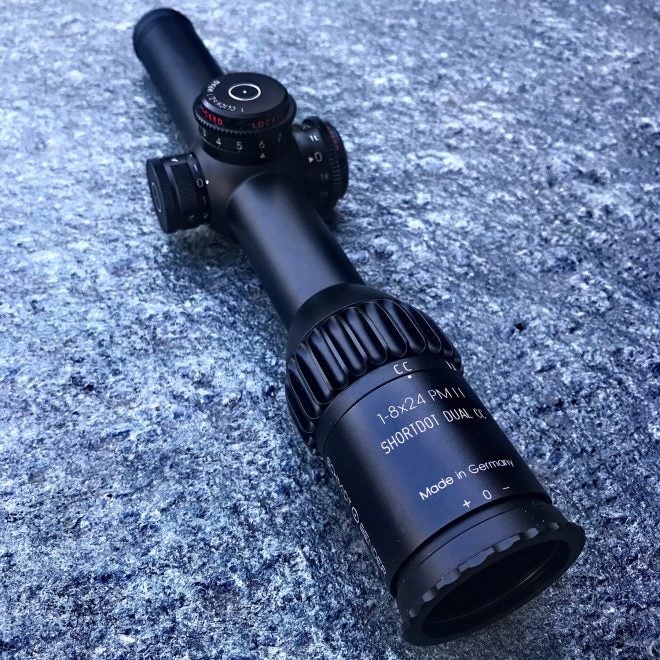
It took a long time for Schmidt & Bender to get this optic to the market after its initial release, but we’re going to forget and forgive all that.
Part of my brain stopped me from buying this black beast. Probably the part of my brain that is still attached to my finances, but in the end, I caught some common sense and ordered it. The money would probably have been wasted in the Coronacrisis stock exchange crash anyway.
To be honest, I was actually prepared to be a little disappointed, but oh boy, was I wrong.
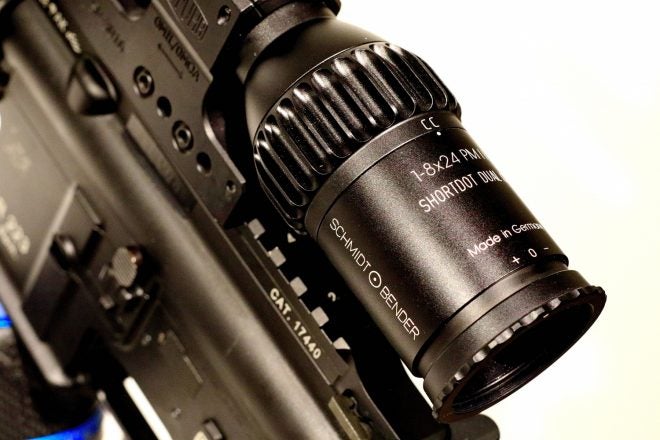
The price doesn’t define everything in a product, but what if we told you that the list price in Europe is over €3,500 without VAT (over €4,000 including VAT)? In the United States it seems to be well over $4,300 in many places, so it kind of defines where this optic is in the market. I know that is an awful lot of money to drop on any optic. But we also know that some people are prepared to do it, just like some people drive a supercar as their daily.
As I was evaluating this S&B, I realized that even if you wanted, and had more money to burn, there is nothing on the market for you to buy. Money-wise this is as expensive as it gets in the Low Power Variable Optic (LPVO) section.
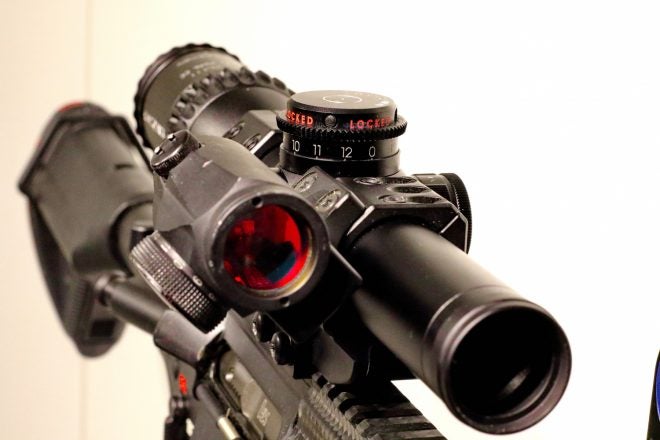
1-8×24 PM II ShortDot Dual CC on a Heckler & Koch MR223. Spuhr mount with an Aimpoint red dot on the side.
As you may know, a lot of countries are looking for these types of optical solutions for their armies: SOCOM Solicits $33 Million Contract for Variable-Power Squad Optics. To my knowledge, no other LPVO riflescope comes close when it comes to military credentials, not yet anyway.
This S&B ShortDot has been chosen by the German Army for (some of) their G28s. Their intention is to use it out to 800 meters. The French Army did the same. As they bought 2,600 SCAR-H rifles, they also bought this optic to be used with Night Vision if needed.
Below: One of my first encounters with the current Dual CC at SHOT Show.
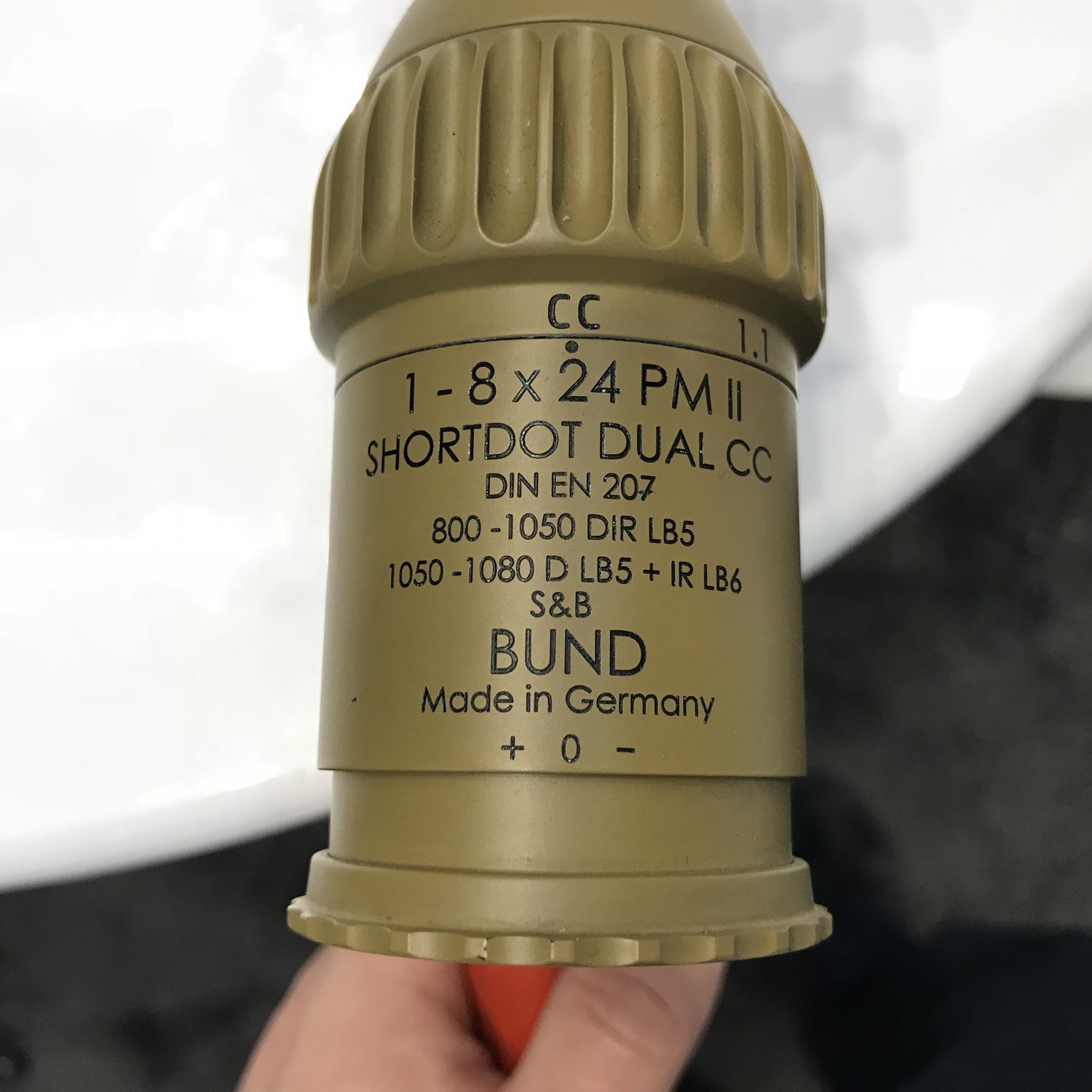
Note the BUND (Federation). Below at the SHOT Show Industry Day At The Range, mounted on a rifle from LMT.
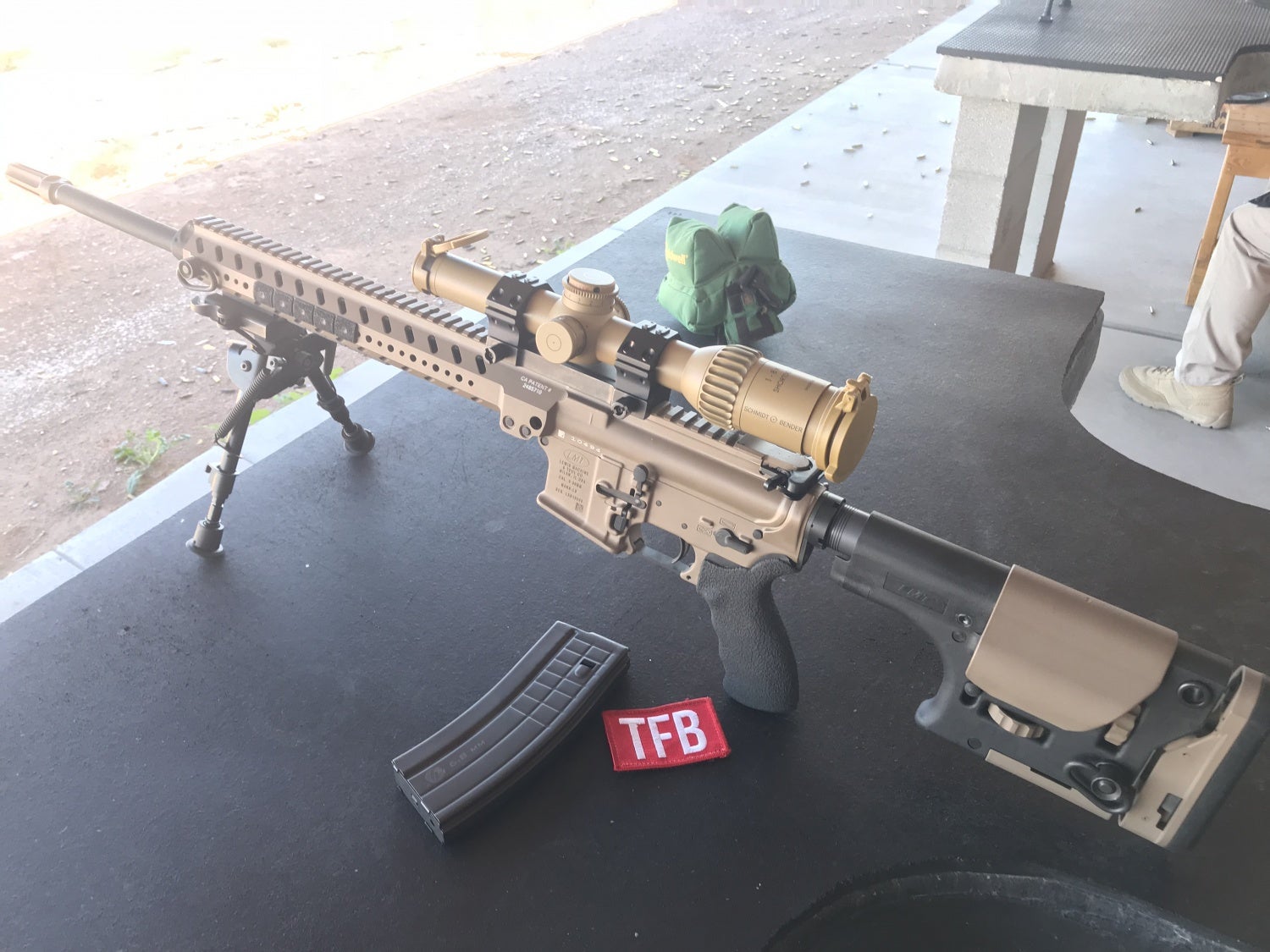
The Low Power Variable Optic market
There are many 1-6 and 1-8 power rifle scopes for hunting and sports shooting, but they all have the reticle in the Second Focal Plane. This means that the reticle stays the same size all the time.
The S&B 1-8x is different as it has the reticle in the First Focal Plane, which allows the Mil Dot-based reticle and its bullet drops to remain true at any magnification. This is more expensive to manufacture, but it allows the shooter to quickly apply the correct hold.
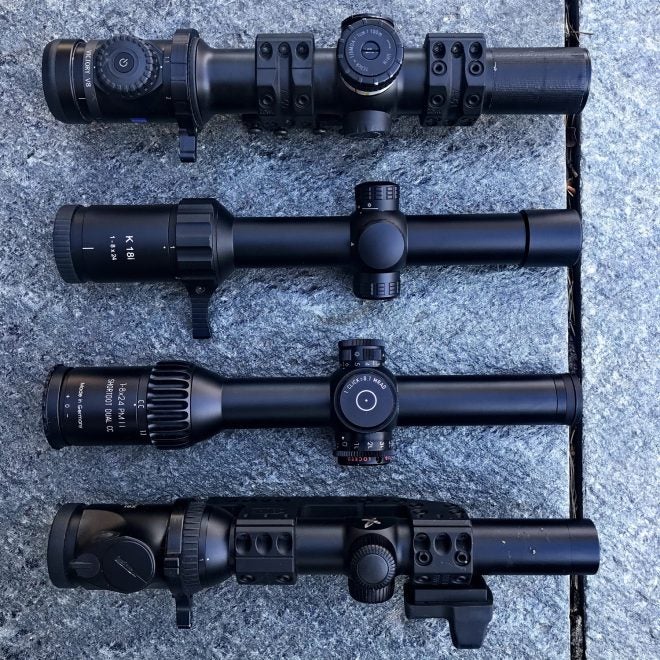
From top to bottom: Zeiss V8 1.1-8x, Kahles K18i, S&B 1-8x Dual CC and Swarovski Z6i 1.6x.
In terms of competitors with reticles in the First Focal Plane (FFP) there are a few.
For instance, we have the Trijicon VCOG 1-8×28 Riflescope, the NightForce ATACR 1-8×24 and the Vortex Optics Razor HD Gen III 1-10×24 FFP. The latter is about to be reviewed soon by TFB.
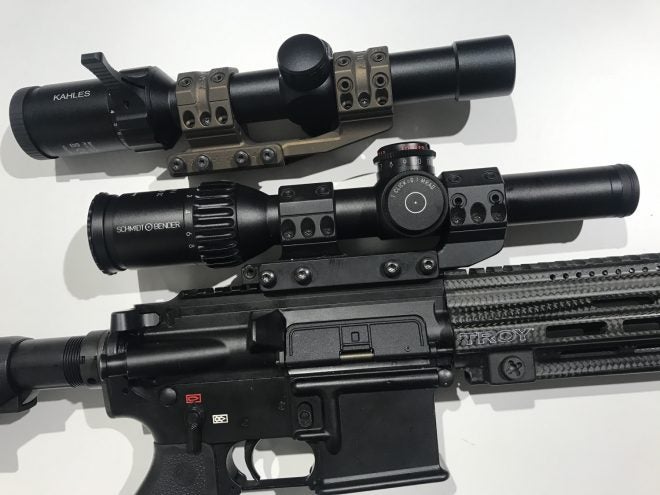
How does the “Dual CC” function work?
Dual stands for dual focal plane. This means that the riflescope has an illuminated, Milliradian based reticle in the First Focal Plane. In the second focal plane, there is a daylight bright Red Dot, which S&B calls FlashDot.
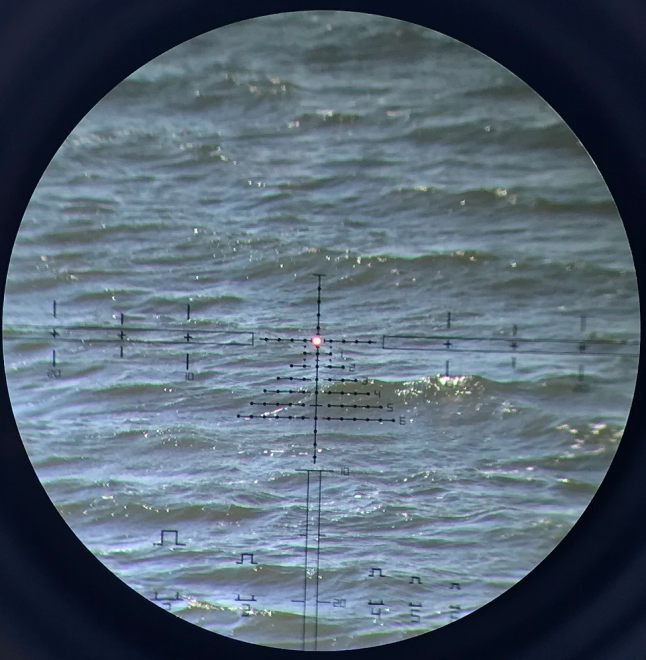
Full 8 power with FlashDot only.
As you change the magnification with the magnification ring, the reticle in the first focal plane will increase with the magnification.

You can use the Mil-based reticle for range finding on any kind of magnification power. Let’s remember that if you don’t know the distance to your target, it is going to get very difficult to hit at longer ranges.
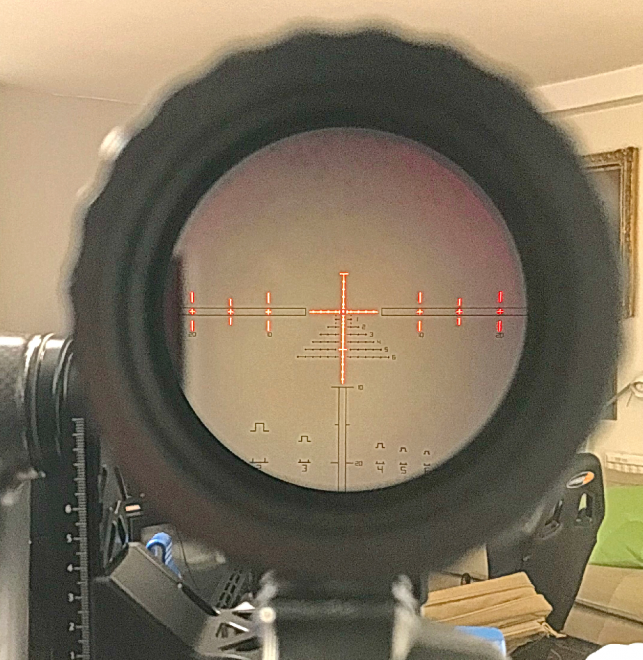
Coming back to the red dot, this will always remain in the same small size as it is in the second focal plane. If you are using the riflescope on 1x magnification, it works as a red dot, and you can shoot with both eyes open and get a great field of view and awareness level of your surroundings.
CC stands for Close Combat. It means that if you are below the 1.1x magnification the parallax is automatically set at 7 meters.
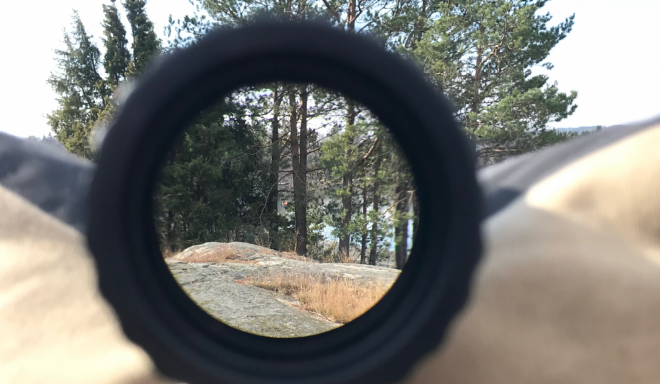
The riflescope is resting on a bag. You can see the red dot in the middle. Unfortunately, it is difficult to capture its real brightness on the camera. It appears much brighter to the eye, but not Kahles K18i bright.
If you set the scope beyond the 1.1 magnification mark the parallax is automatically set at a 100m.
So, there’s a lot of magic going on in this riflescope which may explain why it is priced the way it is.
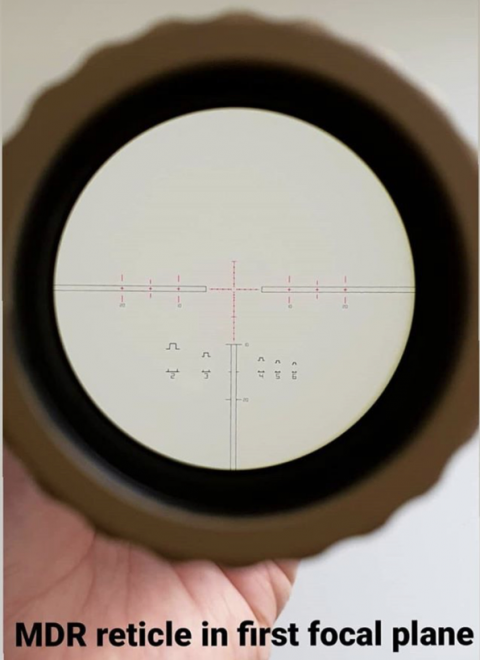
Picture: Schmidt & Bender
The Illumination
The illumination knob is a bit different from other scopes I’ve used. You can actually turn it both up and down, with a zero setting in the middle.
If you turn it upwards, selected parts of the Mil reticle will get illuminated. If you turn it downwards the red dot gets illuminated.
The dot in SFP CC Mode is 1.3 Mil or 4.5 MOA.
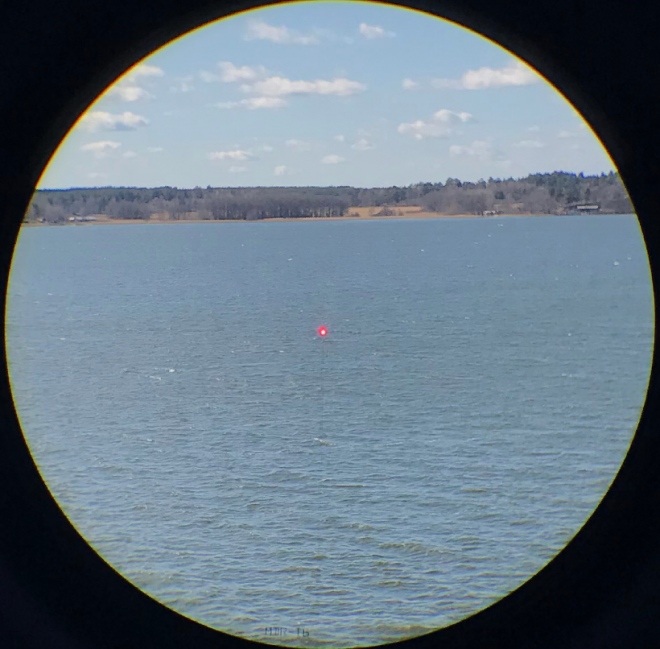
Above you can see the red dot only (or FlashDot as S&B calls it), there is just a hint of the reticle. At low power, it is difficult to see the reticle at all, but you don’t really need it. Below selected parts of the reticle are illuminated.
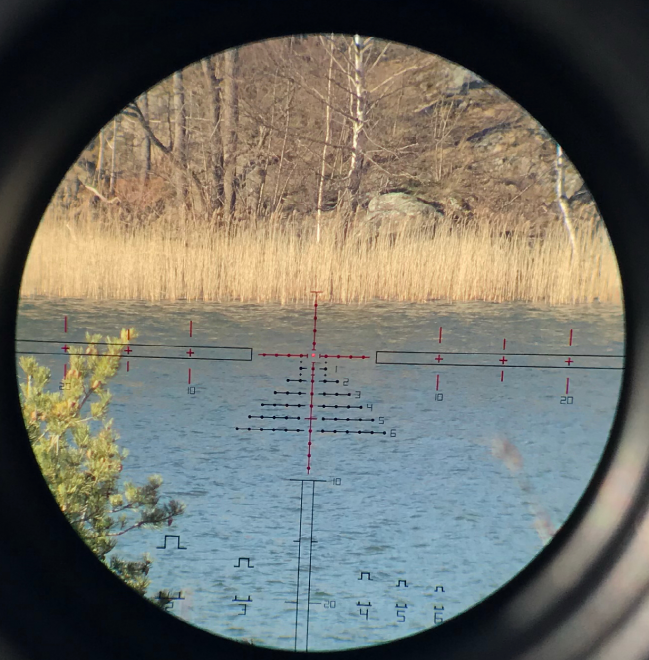
Night Vision Compatibility
The first three out of a total of six steps of the illumination are for Night Vision. Again, a sign of who the intended customers might be.
One wish is for the maximum illumination to be even more intense, but it works well in most cases but it is not desert sun bright.
The knob is simple to use, with a friction ring for improved grip. It’s probably easier to use with gloves than without. You can see the illumination settings below, left knob, up or down depending on if you want to control the FlashDot or the reticle.
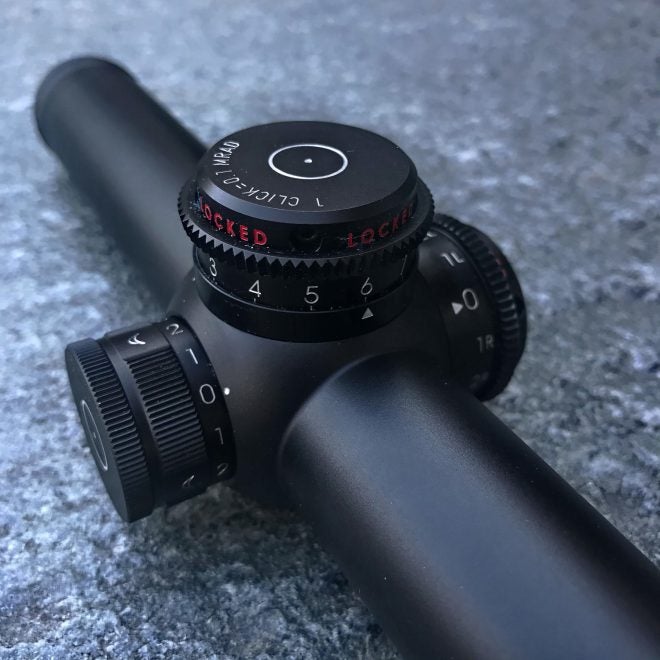
There’s really only one thing to complain about. Unless you shut the illumination off manually, you are going to burn a lot of batteries, ask me how I know. It’s 2020 already, somebody please fix this issue.
The Turrets
I haven’t tried all turrets on the market, but these are among the best I have ever tried. A poor turret can ruin any optic, but that’s far from being the case here. The feeling is just right and the tracking worked perfectly during my testing. The clicking feels precise, tactile and there is a nice audible “click” for every move. You don’t have to look at and verify the turret when you click, the tactile feel is enough. For more information about all S&B turrets, check S&B’s product page which is a great help.
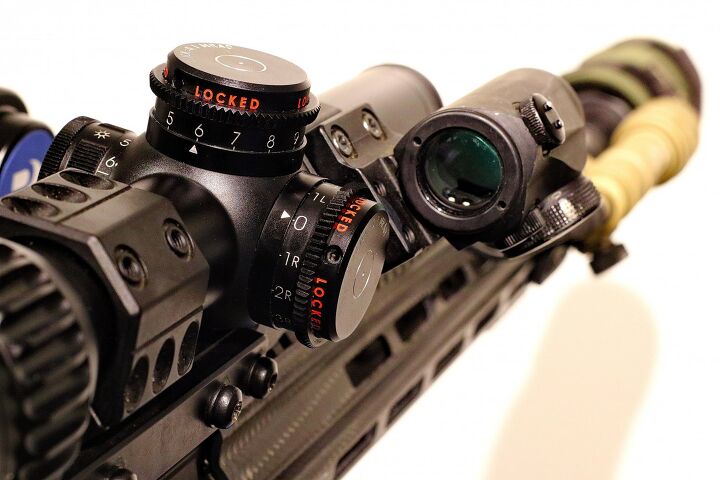
It’s easy to see where your turrets are and how much you have clicked. If you can read “Locked” you are safe, they won’t move. Just lift the outer ring to unlock them.
These are single turn locking turrets that offer 12 MIL of travel (120 cm/100 m, 32 MOA). You can order them as clockwise or counterclockwise and in either 1 cm or 1/4 MOA click values. 1 cm clicks (at 100 m) correlates to your Mil-dot reticle, as this is 0.1 milliradians (MRAD).
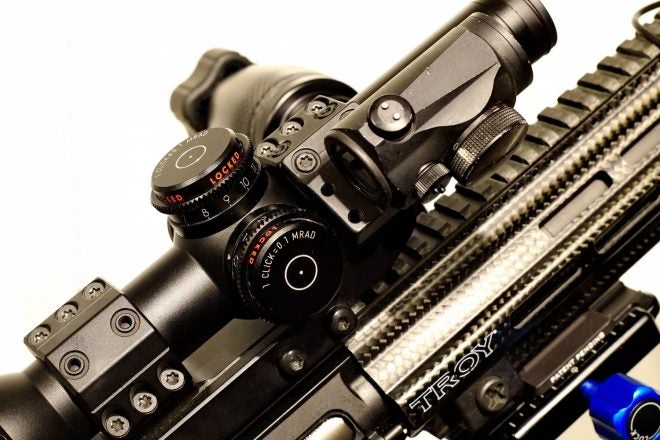
The Schmidt & Bender language decoder
The reviewed riflescope has the following product code: 1-8×24 PM II ShortDot Dual CC MDR-T6 1cm cw ST LT MTC / ST.
A friend did this translator which will help anyone trying to decode the S&B language.
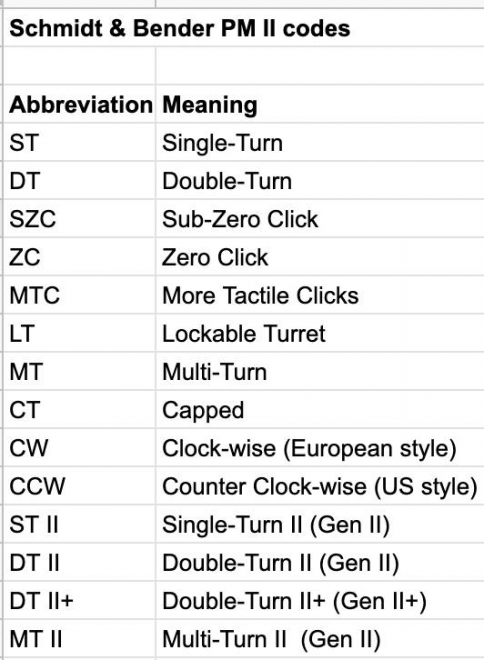
Of course, he had to make some fun about the S&B product codes as well. Now that you have the translator, it all makes sense!? (Check here to make your own custom shirts)

The MDR-T6 Mil Dot-based reticle
You can find the datasheet for the MDR-T6 reticle here. As you can see in the example below, there are a lot of things you can measure once you know your reticle – work with it!
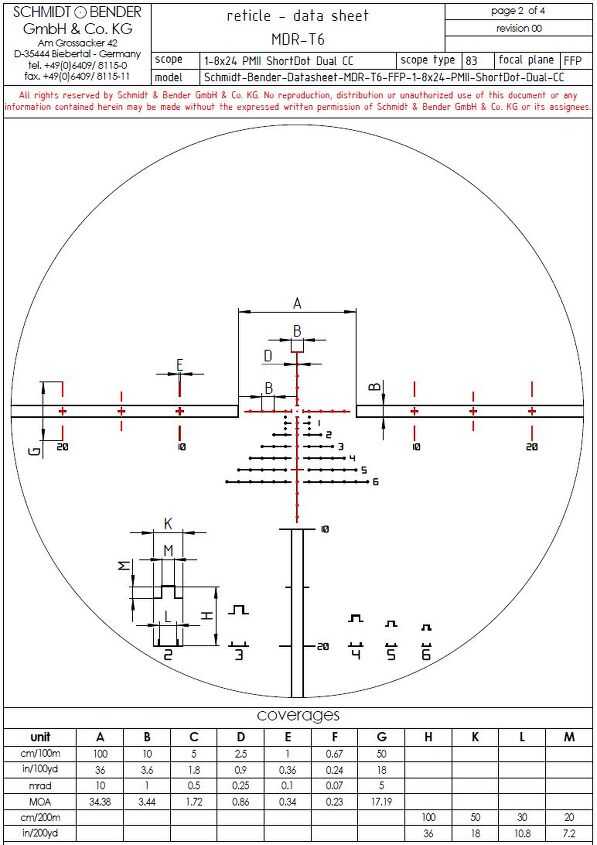
One drawback with FFP optics and high power magnification is that it is very difficult to make a reticle that works in the low-end as well as the top-end of the magnification.
Below: This boat is about 1700 meters away, but still looks good with the parallax fixed to 100 meters. Very cold and windy weather, just above freezing.
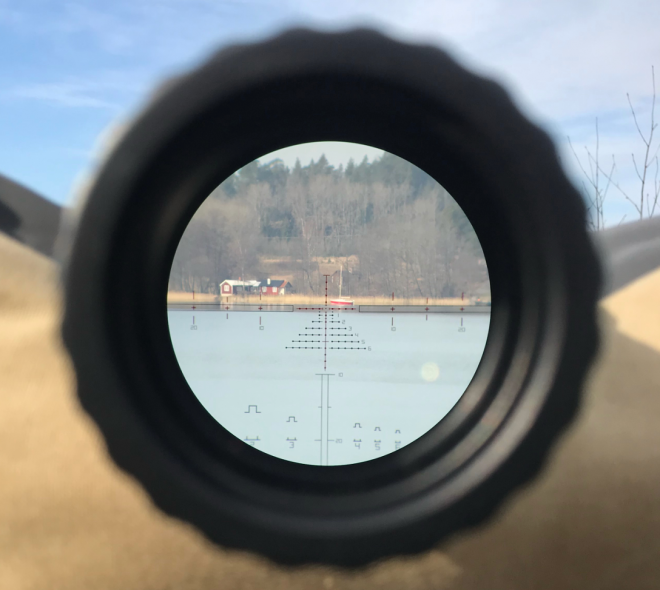
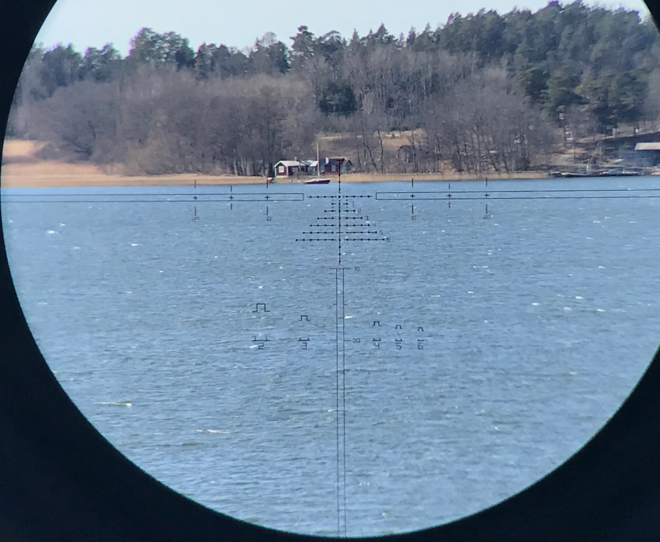
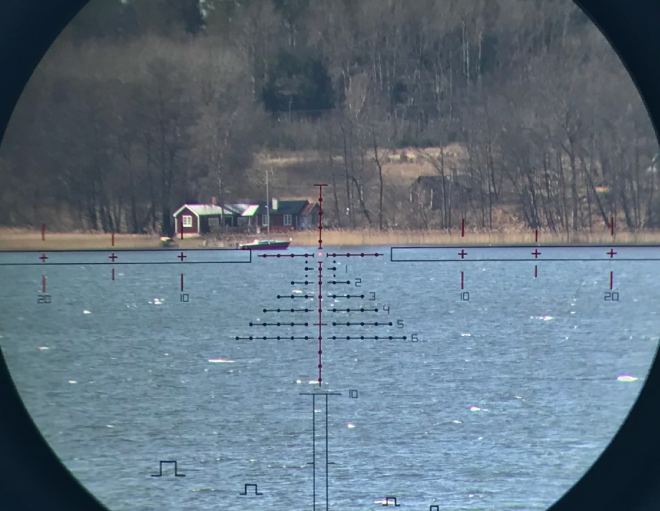
Most reticles work better toward the high-end and the S&B is no exception. However, this is where the “DUAL” function comes in to help, as it has a Red Dot function if you’re using the low end a lot.
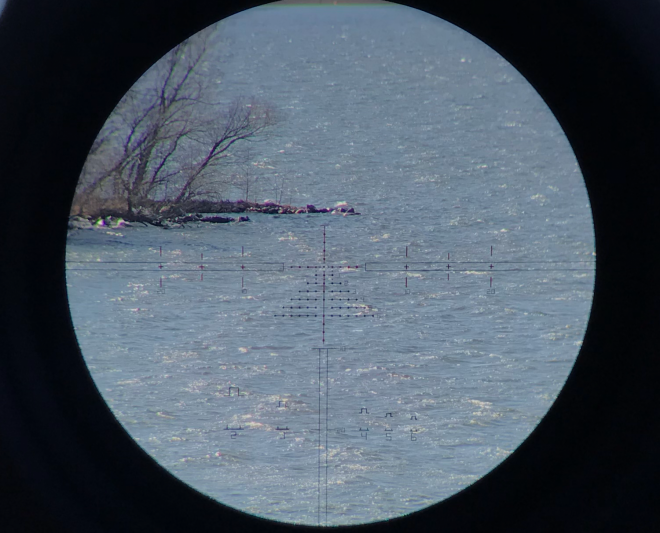
Below: Note the swan in the picture below. The center dot is free and very small, only 0.16 Mil or 0.56 MOA at 8x.
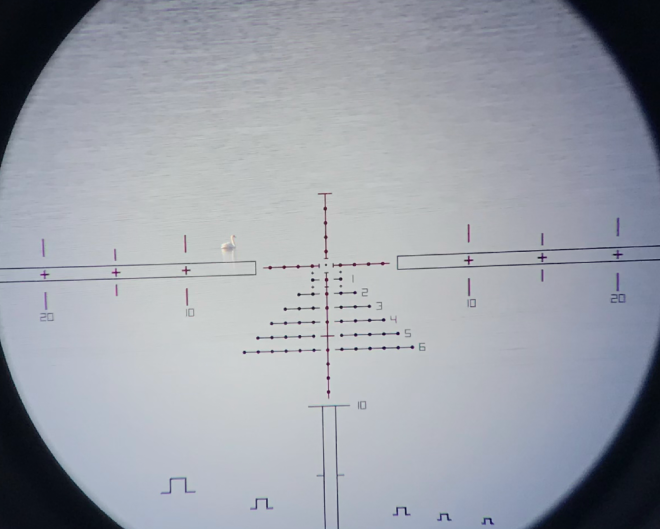
Below: As this is a Mil based reticle and the size of the IPSC target is known, you should be able to measure and calculate that the distance to the paper target was about 80 meters.
If you want to learn more, check Range estimation with MRAD reticles.
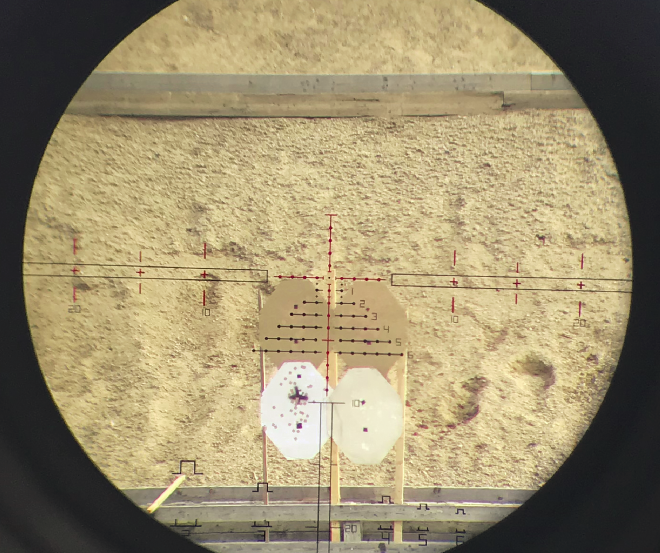
Below: Once I hade zeroed the reticle I shot an impressive group with the Heckler & Koch MR223 (the one inside the black patch!). A vast improvement over the Aimpoint I used before, and probably my best group ever with this rifle. Who said you cannot buy happiness?
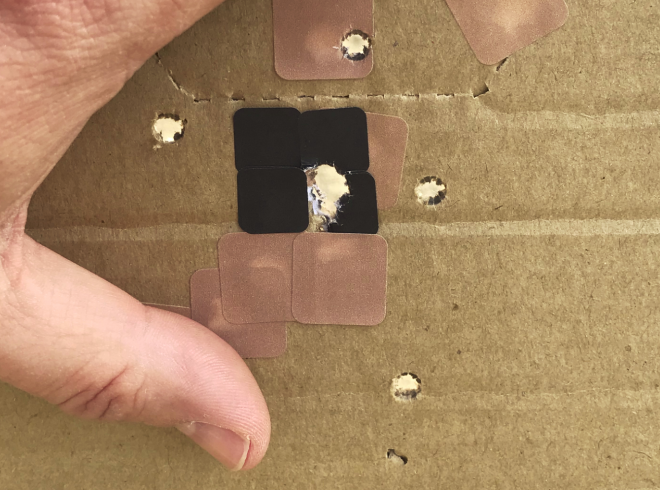
Due to the design, it can sometimes look like the center dot is “walking” in the center as you push your eye towards the edge of the eyebox. I think this is due to the difference in parallax.
Technical Specifications – Field Of View & Weight
I don’t see the point in quoting everything from the datasheet. If you’re interested you can find this information on Schmidt & Bender’s product page and compare it to the other optic of your love. However, there are a few things to point out if you compare this S&B to other optics in the same category.
The Field Of View (FOV) is a little lower than we are used to expecting from the high-end sports rifle optics. The field of view of the S&B 1-8x is 35.3 to 4.9 meters at 100 meters. This means that at 1x power you see just over 35 meters wide. At full 8 power, you see just shy of 5 meters wide. Don’t get me wrong, this is a quite impressive performance.
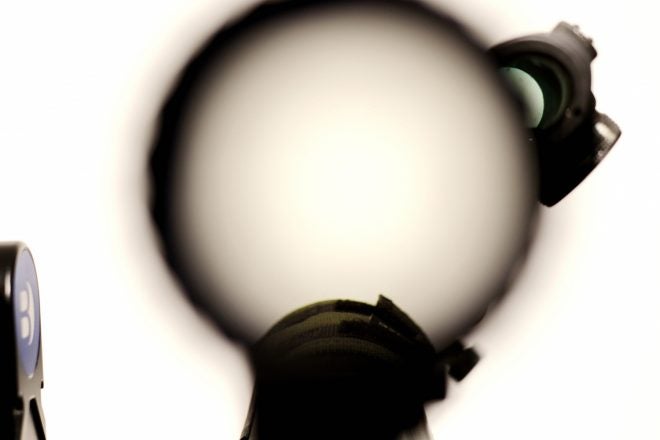
Trying to make an impression of the 1x power, but it’s difficult to take photos through optics.
The Trijicon VCOG offers about the same FOV, with 36.4 – 4.37m at 100m. (109.2 ft. – 13.1 ft. at 100 yds.). I don’t have a VCOG but the Strike Eagle has about the same specs with 109 -14.4 ft at 100 yds.
The pictures below aren’t taken at the same time and the cropping is different, but they are both at 8 power looking at roughly the same spot. Optics are so much more than technical figures, it’s about what the eye and brain perceive.
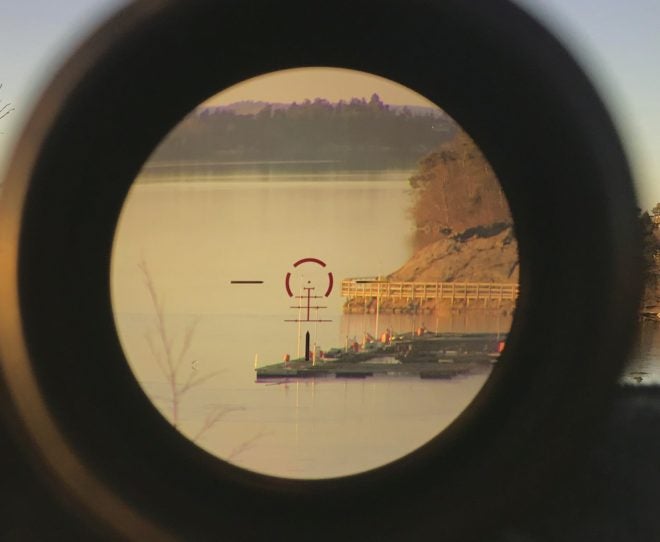
Vortex Strike Eagle 1-8×24 at 8 power.
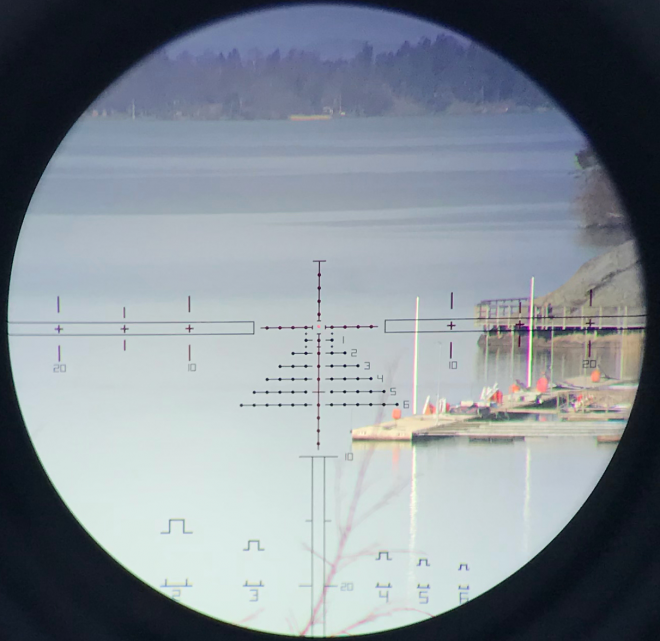
S&B 1-8×24 PM II ShortDot Dual CC at 8 power. The colors are very natural, but towards the blue.
Generally, the best-in-class have up to 42,5 meters down to 5,3 meters FOV (higher value is better), so the ruggedness of the S&B comes at a cost of a little lower Field Of View. I think this is a price that a lot of customers are prepared to pay. During the review, I never really had any issues with the FOV.
Why is a wide FOV important? The wider you can see, the easier it is to discover your surroundings, avoid shooting if someone is accidentally walking into your line of fire, find the next target, etc. The lower the field of view, the more your optic will feel like you’re looking down a straw.

Weight – The S&B weighs 625 g (22 oz), about the same as the Vortex Razor 1-10×24 FFP and the Zeiss Victory V8 1.1-8×30. The Trijicon VCOG is a hammer in comparison, with its 893 grams (31.5 oz). More than 40% heavier than the S&B, but it also includes the mount.
Some people are really peculiar with weight. My perception is that it’s not that important unless you’re really trying to shave off weight. In that case, get a red dot and be done.
Having said that, remember that the weight of a riflescope and the mount is weight at the wrong place (top). But at the end of the day, the balance of your rifle and its ability to keep its zero is more important.
1-8×24 PM II Short Dot Dual CC
| Field of view m/100 m | 35,3–4,9 |
| Exit pupil mm | 9,8–3,0 |
| Eye relief distance | 90 mm |
| Twilight factor | 4,9-13,9 |
| Optical data dptr. | -3/+2 |
| Parallax adjustment | 100 m fixed (7 m in CC-Mode) |
| Weight | 625 gram |
| Reticles | MDR, MDR T6 (tested) |
Service & Warranty
On the S&B webpage, you can find information about service, product registration and their general warranty. I never had an issue with any products from S&B, and the only time I used their service department was for a reticle change in one of my scopes. I received prompt replies, but I know that the delivery time for special orders can be somewhat long.
The Spuhr Mount
The mount in this review is a Spuhr SP-3016 Ø30 H38mm 0MIL (US link). For demonstration purposes, I attached an Aimpoint Micro red dot in the Spuhr A-0025 Interface. The mount worked flawlessly. In the USA, you can find Spuhr mounts and accessories at Mile High Shooting.
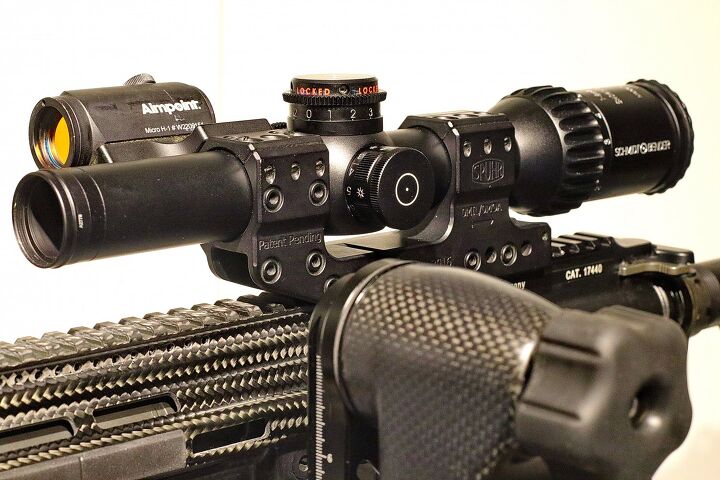
Video: The official video from Schmidt & Bender.
Pros +
- Excellent execution of the Dual function between the red dot and FFP reticle.
- The eyebox and the overall perception of the optic itself (glass) were better than expected.
- Great optical clarity and acuity.
- The turrets are excellent – you’re protected against unintentional adjustment
- Illumination works with Night Vision.
- Very durable, high overall quality.
- Made in Germany – Manual production.
Cons –
- Well, it’s rather expensive.
- Needs a throw lever for the magnification ring (S&B has one, p/n 971-06840 for €89)
- I hope the design people at S&B reads this, because they need to incorporate an auto-shut off function for the illumination.
Update: Schmidt & Bender came with some feedback on the auto-shut off function: “The 1-8 DUAL has an automatic shut off after 6 hrs. We can also make the automatic shut off after 1hr or so if this is required. We have not activated the angle sensor on our PM scopes but this can be done. The angle sensor switch off the illumination automatically if you put your rifle with scope up to 90 degrees etc.”
Conclusion
With the 1x Dual CC setting, it is a great both-eyes-open riflescope. If you zoom in, you can easily both identify and engage targets in the far distance.
An optic with this kind of intention has to be able to survive some serious beating. There is usually a technical cost related to this, but the S&B Dual CC seems to have escaped many of these drawbacks.
The S&B does weigh a little bit more than other sports optics, but it’s almost negligible. Compared to Kahles K18i (also 1-8x), there is a 70 gram (2,47 ounces) difference. If that’s a problem you need to go to the gym more often.
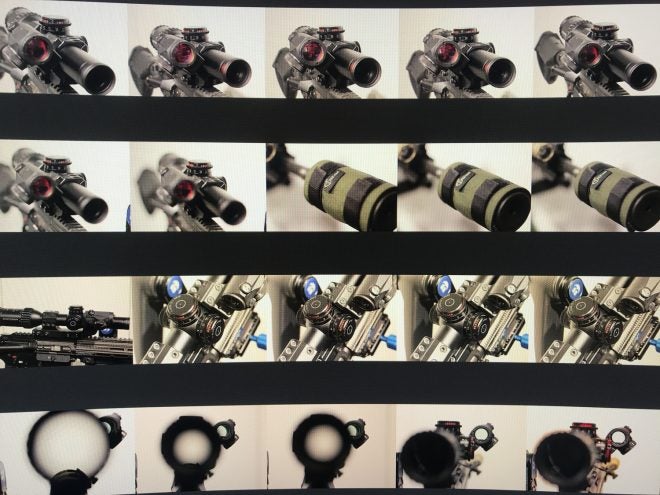
The Field Of View is a little less than what the best sports optics offer today, but the performance is very acceptable.
S&B claims that this is the perfect scope for dynamic rifle shooting like IPSC or 3Gun competition. While it should work just fine for this, I would personally prefer a traditional SFP sports optic for IPSC
Rifle, at least for the distances we mainly see within Europe. With distances of maximum 300 meters and bullet trajectories that are fairly flat within this working area the need for bullet drop compensation isn’t huge.
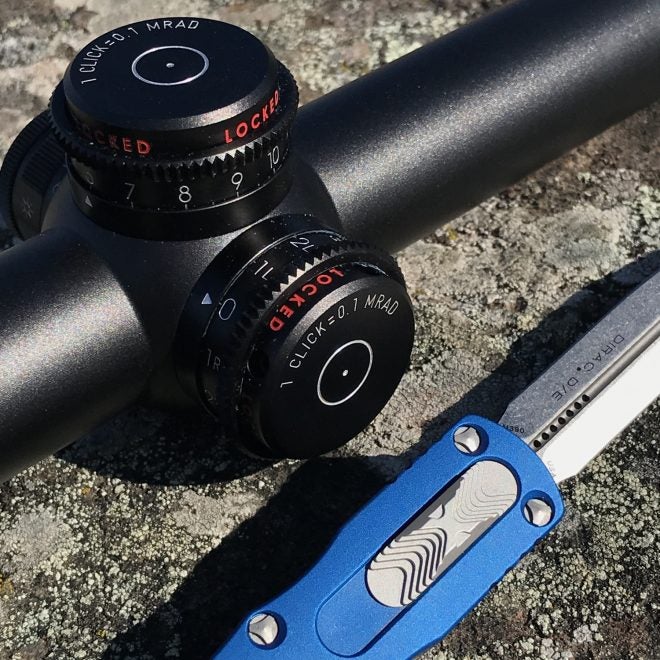
I have to add that due to the Coronavirus there are no matches this season, so I have not been able to do any “live” testing under the pressure of a timer. Another disclaimer is that I have been shooting with second focal plane optics for some 10 years, so I may also be quite conservative in my views.
However, when the going gets tough and I have to call wind and reach out to longer distances, this will be my choice. The distances in 3Gun are generally longer, out to 500-600 meters, and the need for a First Focal Plance reticle increases. Hold-offs, hold-unders, and hold-overs become more important, and this reticle should be able to help you.
It would also be the perfect choice for a luxurious SHTF rifle, although I think most would choose optic with the wallet and just stick a red dot on and be happy for this kind of rifle.

The review is done, and I am quite happy that I don’t have to remove this Schmidt & Bender from my Heckler & Koch MR223 and its Spuhr mount.
The package is kind of a perfect fit in many ways, where the rifle and the caliber (.223 Rem) is probably the weakest link. I just wish I had the FN SCAR-H or the H&K MR762 I never bought for this riflescope.
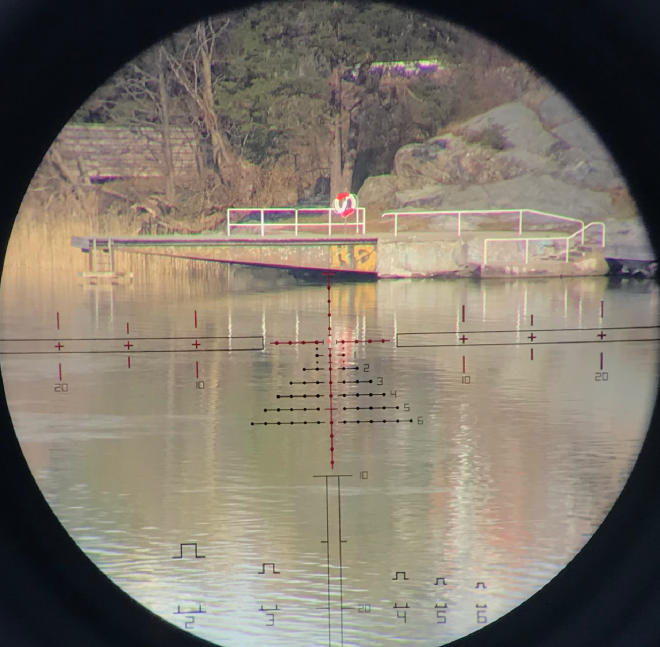
Of course, TFB could not resist building our iteration of the French SCAR-H PR, complete with S&B Dual CC scope and a B&T suppressor. We may have to return to this story in the future, don’t you think?
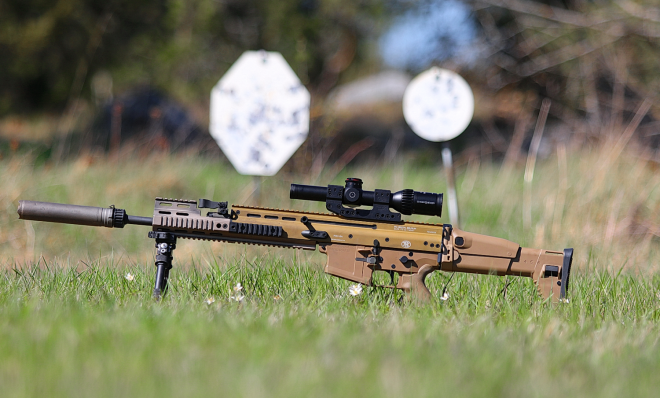
For more information about the products in this review visit the websites of Schmidt & Bender and Spuhr.
We look forward to your comments below. Would you prefer your S&B 1-8x PM II Dual CC in Black or RAL8000?
Please feel free to share this with friends on social media.
We are committed to finding, researching, and recommending the best products. We earn commissions from purchases you make using the retail links in our product reviews. Learn more about how this works.
 Your Privacy Choices
Your Privacy Choices
